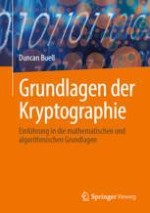2024 | OriginalPaper | Buchkapitel
11. Wie man eine Zahl faktorisiert
verfasst von : Duncan Buell
Erschienen in: Grundlagen der Kryptographie
Aktivieren Sie unsere intelligente Suche, um passende Fachinhalte oder Patente zu finden.
Wählen Sie Textabschnitte aus um mit Künstlicher Intelligenz passenden Patente zu finden. powered by
Markieren Sie Textabschnitte, um KI-gestützt weitere passende Inhalte zu finden. powered by
